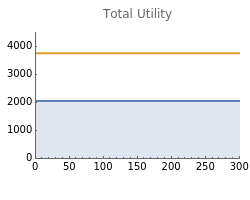Exploring Social Choice Theory
Exploring Social Choice Theory
This Demonstration is devoted to understanding all combinations of five social choice systems; namely the systems of democracy, exchange, theft, oligarchy, and dictatorship. Each run examines the effects of a particular set of social rules on a society of a given number of agents and goods, and a given level of scarcity (the ratio of total goods demand to total goods available, with some random variation). The goal is to explore the effects of different social resource distribution rules on various measures of social and individual utility.
An individual's utility is determined by comparing the goods demanded by that individual to the goods the individual holds in its inventory. The aggregation of these individual utilities is the social utility. Depending on the social rule set, individuals or societies will attempt to reorder inventories to meet a particular utility criterion. By iterating this decision-making process it is possible to observe how certain social choice rules can be expected to allocate resources for a given initial social circumstance.

